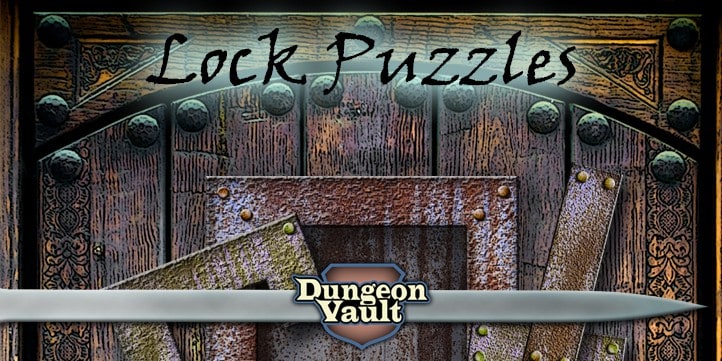
You are looking for a way to include puzzles in your library or on books. I have just the thing! Here are six puzzle setups for bookwurms.
1. Enter the Library Puzzle
The first puzzle in this list is a free puzzle I designed. Players must solve the puzzle on the double library doors to enter it.
Players must discover the correct word and speak it out loud to enter the library. What I like about this puzzle is that it is a single image you can show players and it needs no further explaination.
If players get stuck, allow them to make an intelligence check. If they succeed, only give away the next step of the puzzle solution. This way, you’re challenging both the players AND their characters.
You can get this puzzle here. Also, there are 5 alternative free puzzles you can use in my newsletter.
2. Explore the Library Puzzle
Once players have entered the library, they’ll wish to explore it. But instead of just letting them roam around, let’s make it challenging. With Dungeon Puzzles you can turn the entire library layout into a giant puzzle.
Players must first solve the dungeon puzzle to rotate pieces of the library so all hallways match. You can do this for the entire library or just sections of it. It’s a bit like the moving staircases in Harry Potter, but with a twist.
3. The Library Book Cover Puzzle
So your players have explored the library and located a book they wish to open. Not so fast! Even opening a book should be a puzzle.You can place D&D puzzles on book covers as well. For example:
“Doerak the barbarian, Stickyfingers the rogue, and Laudius the wizard explore the library in search for a cure for mummy rot. They quickly find a book titled ‘Mummy rot through the ages’ a promising title. But alas! The book has been locked with a rune puzzle which looks like this.

Laudius orders everyone to study the runes and spread out in the hopes of finding clues to their meaning. Stickyfingers finds a note that translates a rune word. And Doerak finds a clue in ‘Runecasting, an introduction’ which looks like this.

A clue needed to solve the rune puzzle
After collecting all the clues, Laudius solves the rune puzzle and unlocks ‘Mummy rot through the ages’. In it, he finds more translations to runes, which might help him solve different rune locks. But he also finds two lines to the recipe for curing mummy rot.”
This is just one example of how to lock a book with a D&D puzzle. I’ve used Rune Puzzles which contains 30 puzzles you can drop into any book cover in an instant. Just hide the clues around the library and you’re done.
Alternatively, you can use Lock Puzzles to lock your more heavy books with iron seals. These locks can be placed onto anything really, but they do look great on a heavy wizard’s tome.
4. Puzzles in books
When your D&D players finally manage to open a tome they’re confronted by the next puzzle. Potion Puzzles are perfect for putting into tomes because this puzzle pack is really a complete system for creating magical items of all kinds in your campaign. And that really is the type of knowledge players hope to find when scouring an arcane library.
With potion puzzles players must first find the clues to the recipe for creating a potion, oil, salve, perfume, or any other magical liquid. This liquid is the key ingredient in any type of magical object they wish to create. So if they wish to create a sword, for instance, the final step might be to use a magical oil. (Of course, the DM decides what the liquid is for so you have total control).
Once players have all the clues they must still find the ingredients for brewing the potion. You can place information on where to find ingredients in other books. And collecting all those ingredients can be a side quest in and of itself. Or they might just be sitting as potted plants on top of bookcases, your choice.
5. The extra hint puzzle
Even though players can make intelligence checks to avoid getting stuck on a puzzle, it is always a good idea to have a back up route so you can offer multiple ways they can reach their goal. I like to use either a ghost librarian who will ask the players a riddle in exchange for providing the next clue to a puzzle.
Small riddles can be a lot of fun, but you will need a lot of them. I use the deck of 101 riddles for this. It is absolutely as easy as it sounds. Players can ask the librarian ghost for a clue and you draw a riddle card from the deck. Here’s an example:

The way this riddle works is that the players must find a synonym for both the first and the second word that make sense together. Another word for tobacco-burner is ‘pipe’, and another word for sack is ‘terminate’. But the combined word ‘terminate-pipe’ doesn’t make sense. Another word for sack would be ‘bag’. Combined they make ‘bagpipe’ which does make sense.
6. The Vault Bundle

While creating a D&D library and book puzzles is a lot of fun, you will need a ton of illustrated puzzles to pull it off. Luckily I’ve created the Vault Bundle which contains over two hundred illustrated puzzles that are perfect for creating puzzle libraries. You get all the convenience of not having to go through the hassle of designing and illustrating puzzles yourself, but also the freedom of laying them out in a way that works for you. So be sure to check that out!







